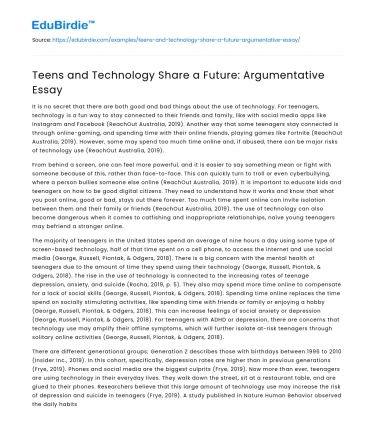It is no secret that there are both good and bad things about the use of technology. For teenagers, technology is a fun way to stay connected to their friends and family, like with social media apps like Instagram and Facebook (ReachOut Australia, 2019). Another way that some teenagers stay connected is through online-gaming, and spending time with their online friends, playing games like Fortnite (ReachOut Australia, 2019). However, some may spend too much time online and, if abused, there can be major risks of technology use (ReachOut Australia, 2019).
From behind a screen, one can feel more powerful, and it is easier to say something mean or fight with someone because of this, rather than face-to-face. This can quickly turn to troll or even cyberbullying, where a person bullies someone else online (ReachOut Australia, 2019). It is important to educate kids and teenagers on how to be good digital citizens. They need to understand how it works and know that what you post online, good or bad, stays out there forever. Too much time spent online can invite isolation between them and their family or friends (ReachOut Australia, 2019). The use of technology can also become dangerous when it comes to catfishing and inappropriate relationships, naïve young teenagers may befriend a stranger online.
Save your time!
We can take care of your essay
- Proper editing and formatting
- Free revision, title page, and bibliography
- Flexible prices and money-back guarantee
The majority of teenagers in the United States spend an average of nine hours a day using some type of screen-based technology, half of that time spent on a cell phone, to access the internet and use social media (George, Russell, Piontak, & Odgers, 2018). There is a big concern with the mental health of teenagers due to the amount of time they spend using their technology (George, Russell, Piontak, & Odgers, 2018). The rise in the use of technology is connected to the increasing rates of teenage depression, anxiety, and suicide (Rocha, 2019, p. 5). They also may spend more time online to compensate for a lack of social skills (George, Russell, Piontak, & Odgers, 2018). Spending time online replaces the time spend on socially stimulating activities, like spending time with friends or family or enjoying a hobby (George, Russell, Piontak, & Odgers, 2018). This can increase feelings of social anxiety or depression (George, Russell, Piontak, & Odgers, 2018). For teenagers with ADHD or depression, there are concerns that technology use may amplify their offline symptoms, which will further isolate at-risk teenagers through solitary online activities (George, Russell, Piontak, & Odgers, 2018).
There are different generational groups; Generation Z describes those with birthdays between 1996 to 2010 (Insider Inc., 2019). In this cohort, specifically, depression rates are higher than in previous generations (Frye, 2019). Phones and social media are the biggest culprits (Frye, 2019). Now more than ever, teenagers are using technology in their everyday lives. They walk down the street, sit at a restaurant table, and are glued to their phones. Researchers believe that this large amount of technology use may increase the risk of depression and suicide in teenagers (Frye, 2019). A study published in Nature Human Behavior observed the daily habits and overall mental health of nearly 350,000 teenagers (Frye, 2019). Researchers concluded that technology use was negatively linked to mental health (Frye, 2019). There have been numerous studies that have said that changes in mental health can lead to greater use of technology (Frye, 2019). Another study published in Clinical Psychological Science surveyed how social media use and depressive symptoms had changed in teenagers over a period of several years (Frye, 2019). Researchers found that depressive symptoms predicted greater social media use mostly in teenage girls (Frye, 2019).
For people of all ages, especially teenagers, technology use is all about moderation (ReachOut Australia, 2019). Setting healthy limits is important to reduce the overuse of technology by teenagers (Rocha, 2019, p. 7). Teenagers need to learn how to balance their activities so that they don’t spend hours on their technology (ReachOut Australia, 2019). Parental involvement may help to ease some of the risks that may come with technology use (Rocha, 2019, p. 5). Specialists recommend “active monitoring” rather than “restrictive monitoring” (Rocha, 2019, p. 6). Active monitoring can be anything from co-viewing the technology with their teens to checking their teen’s phone or keeping it with them at night (Rocha, 2019, p. 6). Parents can also help by limiting screen time and replacing it with physical exercise, learning, and other types of off-screen play (ReachOut Australia, 2019). It is also very important to have face-to-face time with people (ReachOut Australia, 2019). Finally, there should also always be an open line of communication between teenagers and their parents (Rocha, 2019, p. 6). Conversations can be structured or unstructured, like a family dinner, and families should talk about types of media, why their teen likes them, and how to use them responsibly (Rocha, 2019, p. 6).






 Stuck on your essay?
Stuck on your essay?

